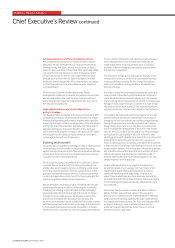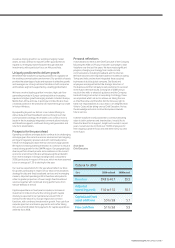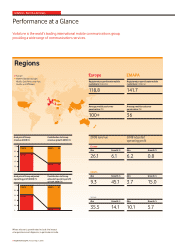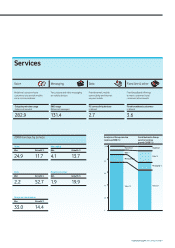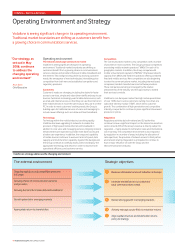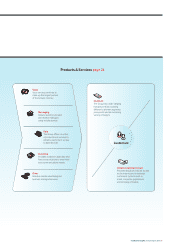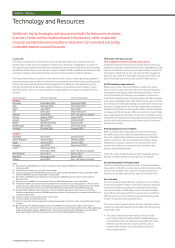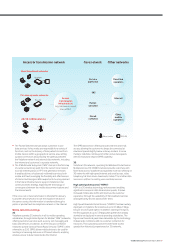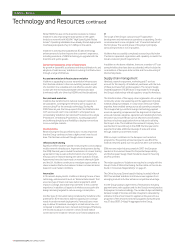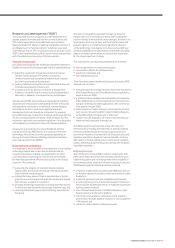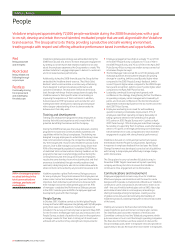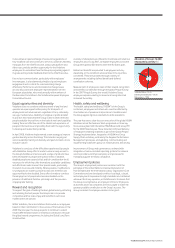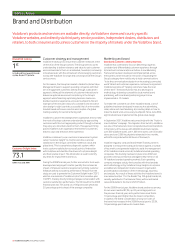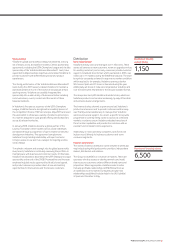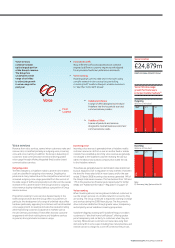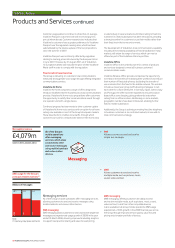Vodafone 2008 Annual Report Download - page 18
Download and view the complete annual report
Please find page 18 of the 2008 Vodafone annual report below. You can navigate through the pages in the report by either clicking on the pages listed below, or by using the keyword search tool below to find specific information within the annual report.
Network infrastructure
How Vodafone’s network infrastructure works
Vodafone’s network infrastructure is fundamental to the Group
being able to provide mobile and fixed voice, messaging and data
services. The Group’s customers are linked to the access part of
the network, which links to the core network that manages the
set-up of calls, transfer of messages and data connections and
allows the Group to provide a wide variety of other services.
2G/3G mobile access network
When a voice call or data transmission is made on a mobile
device, voice or data is sent from the device and transmitted by
low powered radio signals to the nearest base station, which in
turn is connected to the Group’s core network via the access
transmission infrastructure. Each base station provides coverage
over a given geographic area, often referred to as a cell. Cells can
be as small as an individual building or as large as 20 miles across
and each is equipped with its own radio transmitter and receiver
antenna. This network of cells provides, within certain limitations,
coverage over the service area. When a customer using a mobile
device approaches the boundary of one cell, the mobile network
senses that the signal is becoming weak and automatically hands
over the call to the transmission unit in the next cell into which
the device is moving.
Fixed broadband access network
When communication takes place over fixed line networks,
the traffic flows over a traditional wired infrastructure until
the point it reaches the Vodafone access device (a “DSLAM”),
where it connects to the access transmission infrastructure.
Additionally, corporate customers can connect their local
network to Vodafone’s access transmission infrastructure
directly using a dedicated link.
In the UK market, Vodafone delivers fixed broadband services
through a reseller agreement with the local incumbent.
Access transmission infrastructure
The access transmission network is the connection between a
base station, a DSLAM, or a corporate customer’s dedicated line,
and the core network. This consists of mainly leased lines or
Vodafone’s own transmission lines, such as microwave links.
Core network
The core network is responsible for setting up and controlling
connections between mobile or fixed line customers attached
to access networks by locating the called party and routing
voice calls towards it. Additionally, the core network handles
data traffic by allowing customers to access service platforms
offering services such as Vodafone live!, web browsing, email,
mobile TV and other data related services.
The core network comprises three domains, with each domain
containing nodes with specific functionality interconnected by
transmission links:
The Circuit Switched domain enables voice and video
calls. Its key nodes are switches (which manage the set-up
of connections) and user databases, storing the information
needed to provide services to each customer, such as
location in the network, list of subscribed services and
home/visited network.
•
Technology and Resources
Licences
The Group is dependent on the licences it holds to operate mobile communication services.
Further detail on the issue and regulation of licences can be found in “Regulation” on page 147.
The table below summarises the significant mobile licences held by the Group’s mobile operating
subsidiaries and the Group’s joint venture in Italy at 31 March 2008. In addition, the Group also has
a number of licences to provide fixed line services in many countries in which it operates.
The Group holds sufficient spectrum in the majority of the Group’s mobile operating subsidiaries
and joint ventures, which meet the medium term requirements for forecast voice and data growth.
There is also the possibility of enhancing the medium term needs for voice and data capacity
through the refarming of the Group’s existing holdings to more efficient technologies. In areas
where the Group needs to increase capacity, it will participate on an opportunity basis in future
auctions.
Country by region 2G licence expiry date 3G licence expiry date
Europe
Germany December 2016 December 2020
Italy February 2015 December 2021
Spain July 2023(1) April 2020
UK See note 2 December 2021
Albania June 2016 N/A – No licences issued
Greece August 2016(3) August 2021
Ireland May 2011(4) October 2022
Malta(5) September 2010 August 2020
Netherlands March 2013 December 2016
Portugal October 2021 January 2016
EMAPA(6)
Australia See note 7 October 2017
Czech Republic January 2021 February 2025
Egypt January 2022 January 2022
Hungary July 2014(8) December 2019(9)
India(10) November 2014 –
December 2026 N/A – No licences issued
New Zealand See note 11 March 2021(11)
Romania December 2011 March 2020
Turkey April 2023 N/A – No licences issued
Notes:
(1) Date relates to 1800 MHz spectrum licence. Spain also has a separate 900 MHz spectrum licence which expires
in February 2020.
(2) Indefinite licence with a one year notice of revocation.
(3) The licence granted in 1992 (900 MHz spectrum) will expire in September 2012. The licence granted in 2001
(900 and 1800 MHz spectrum) will expire in August 2016.
(4) Date refers to 900 MHz licence. Ireland also has a separate 1800 MHz spectrum licence which expires in
December 2015.
(5) Malta also holds a WiMAX licence, granted in October 2005 and which expires in October 2020.
(6) In December 2007, a consortium including Vodafone was named as the successful applicant in the auction for
a mobile licence in Qatar. Subject to regulatory approvals, the licence is expected to be awarded in June 2008.
Services are expected to be launched under the Vodafone brand by the end of the 2009 financial year.
(7) Australia holds a 900 MHz spectrum licence. This is a rolling five year licence which expires in June 2012.
Vodafone Australia also holds two 1800 MHz spectrum licences. One of these licences expires in June 2013 and
the other in March 2015.
(8) There is an option to extend this licence for seven years.
(9) There is an option to extend this licence.
(10) India is comprised of 23 service areas with a variety of expiry dates. There is an option to extend these licences by
ten years.
(11) By the end of March 2008, New Zealand owned two 900 MHz licences (each 2x7.5 MHz), which expire in
November 2011 and in June 2012. These licences are expected to be renewed until November 2031. Additionally,
Vodafone New Zealand owns a 1800 MHz spectrum licence (2x15 MHz) and a 2100 MHz licence (2x15 MHz),
which expire in March 2021. All licences can be used for 2G and 3G at Vodafone’s discretion.
Vodafone’s key technologies and resources include the telecommunications
licences it holds and the related network infrastructure, which enable the
Group to operate telecommunications networks in 22 controlled and jointly
controlled markets around the world.
Vodafone – Business
16 Vodafone Group Plc Annual Report 2008


